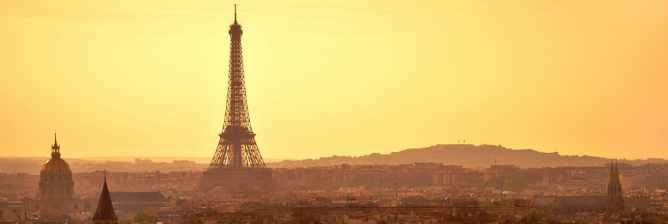
Chanel, Dior, Saint Laurent, Hermes, Louis Vuitton…the list is extensive and ever-expanding. French designers have long created the most renowned and coveted fashion brands in the world. Stylistically innovative and technically exceptional, the outstanding reputation of the French clothing industry can be traced as far back as the 17th century, and it is a reputation that has only continued to strengthen since.
The French arguably owe their original chic to King Louis XIV, the ‘Sun King’ whose reign began in 1643. Louis had particularly lavish taste, evident in the spectacular Palace of Versailles (the expansion of which he commissioned) as well as in the way that he dressed. Recognizing the importance of luxury goods to the national economy, Louis brought a number of artistic industries, including the textile trade, under the control of the royal court, which became the worldwide arbiter of style. For centuries to come, the highest quality fabric and materials were to be found in France.
Thus when the craft of haute couture (fitting clothing to a specific client) flourished in the late 19th century, seamstresses and tailors had no choice but to establish their premises in France. Charles Frederick Worth, the Englishman credited with developing a haute couture industry, was the first to open his business on Paris’s Rue de la Paix, with several other fashion houses following suit – Paul Poiret and Madeleine Vionnet among them. Before long, Paris had become a thriving fashion hub, while French designs were being replicated the world over.
1950s fashion – a nipped-in waist and A-line skirt © virgo200745/Flickr
Of these fashion houses, arguably the most famous – as remains the case today – was that of Coco Chanel. To say that Chanel changed the fashion industry would be an understatement – she completely deconstructed women’s clothing as it had been known by eradicating the corset, an incredibly painful undergarment which manipulated the upper-body into the culturally-idealistic shape. She instead favored loose free-flowing designs, the popularity of which soared during the 1920s, becoming the look that was to define an era – the ‘flapper style.’
France’s fashion industry significantly languished during the Second World War. Under Nazi occupation Chanel’s store was forced to close, along with several other maisons de couture. The USA took advantage of the opportunity to establish its own sartorial presence, diverting the attention of the press towards American designers like Claire McCardell.
Yves Saint Laurent at work in his studio © Victor Soto/Flickr
After years of strict rationing and textile shortages, the clothing industry’s revival was to be brought around by yet another French visionary. Christian Dior dominated post-war fashion with what came to be known as the ‘new look.’ Characterized by a nipped-in waist and an A-line skirt falling to mid-calf, the ‘new look’ made for a feminine and elegant silhouette. It was controversial at first, not least because Dior’s extravagant garments required a great deal of fabric amidst ongoing shortages in the war’s aftermath. In response to criticism, the French designer defiantly declared that ‘Europe has had enough of bombs, now it wants to see fireworks.’ Promoting post-war optimism, Dior’s house was subsequently inundated with orders, reinstating Paris as the most fashionable city in the world.
The 20th century saw a plethora of designers surface. In Paris, the likes of Hubert de Givenchy and Pierre Balmain emerged, both of whom maintained the reputation of the French industry. But there was an increasingly significant level of competition arising from both the USA and Italy, where in 1951 businessman Giovanni Battista Giorgini arranged a show promoting the work of Italian designers, which proved remarkably successful and served to establish the country as a powerful fashion contender.
French fashion brand Louis Vuitton © nwhitford/Flickr
But perhaps the most significant challenge to France’s preeminence came during the 1960s. ‘Youth culture’ was rapidly developing in London, with Mary Quant leading the charge. Quant was a British designer whose daringly short ‘mini-skirts’ were adored by the increasingly influential younger generations promoting emancipation and sexual liberation – the fundamental principles of various counter-culture movements that would prevail throughout the decade. Quant’s audacious designs were quite the contrast to the sophisticated, rather formal creations produced in Paris, which were marketed at a considerably older demographic.
But it was the young Yves Saint Laurent who had perhaps the most significant impact upon the industry towards the end of the 1960s and into the following decade. Saint Laurent was not only responsible for the transition of a number of men’s designs into the female wardrobe – most notably ‘le smoking,’ or ‘dinner jacket’ – his was also the first couture brand to produce a ready-to-wear collection. By doing so, he rendered ready-to-wear fashionable, becoming increasingly popular with the public for whom the rather elitist fashion industry suddenly became much more accessible. Nowadays, almost all of what were originally couture houses produce ready-to-wear lines, which receive significantly higher press coverage than the couture collections and are also much more profitable.
Paris Fashion Week Autumn/Winter 2015 © Aveda Corporation/Flickr
Paris remains today an official fashion capital, alongside Milan, New York and London as well as an increasing number of cities seeking to cement their presence in the industry – Barcelona, Berlin, and Singapore especially. Despite a considerable degree of competition from these cities, fashion is a deep-rooted aspect of France’s culture and its international profile – and most likely always will be.





One thought on “How France Became the Fashion Capital Of The World | Perfume”
hmmm informative info about france perfume